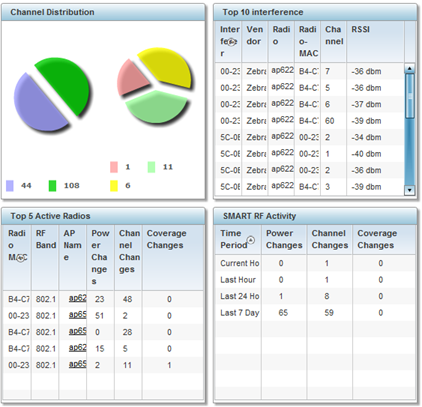SMART RF - Summary
The Summary screen enables administrators to assess the efficiency of RF Domain member device channel distributions, sources of interference potentially requiring Smart RF adjustments, top performing RF Domain member device radios and the number of power, channel and coverage changes required as part of a Smart RF performance compensation activity.
To view the Smart RF summary for RF Domain member access point radios:
- Select the Statistics menu from the Web UI.
- Expand the System node on the top, left-hand side of the screen.
The System node expands to display the RF Domains created within the managed network.
- Select an RF Domain from the list.
The RF Domain statistics menu displays in the right-hand side of the screen, with the Health tab selected by default.
- Select SMART
RF from the RF Domain menu.
The SMART RF Summary screen displays by default.

The Summary screen displays the following SMART RF related statistics:
- Use the Channel Distribution area to determine how RF Domain member devices are utilizing different channels to optimally support connect devices and avoid congestion and interference with neighboring devices. Use this data to assess whether the channel spectrum is being effectively utilized and whether channel changes are warranted to improve RF Domain member device performance.
- Review the Top
10 interference table to assess RF Domain member devices whose level of
interference exceeds the threshold set (from -100 to -10 dBm) for acceptable
performance.
Interferer Lists the administrator defined name of the interfering RF Domain member device. Vendor Displays the vendor name (manufacturer) of the interfering RF Domain member device radio. Radio MAC Displays the factory encoded hardware MAC address assigned to the RF Domain member device radio. Channel Displays the channel each of the 10 poorly performing RF Domain member devices was detected on. Numerous interfering devices on the same channel could define the need for better channel segregation to reduce the levels of detected interference. RSSI Lists a RSSI (received signal strength indication) in dBm for those RF Domain member devices falling into the poorest performing 10 devices based on the administrator defined threshold value. - Review the Top
5 Active Radios to assess the significance of any Smart RF initiated
compensations versus their reported top performance.
Radio MAC Lists the hardware-encoded MAC address of each listed top performing RF Domain member device radio. RF Band Displays the top performing radio‘s operation band. This may help administrate whether more changes were required in the 2.4 GHz band then 5 GHz or vice versa. AP Name Lists the administrator-assigned AP name used to differentiate from other RF Domain member AP radios. The name displays in the form of a link that you can select to vie device information in greater detail. Power Changes Displays the number of Smart RF initiated power level changes reported for this top performing RF Domain member radio. Channel Changes Displays the number of Smart RF initiated channel changes reported for this top performing RF Domain member radio. Coverage Changes Displays the number of Smart RF initiated coverage changes reported for this top performing RF Domain member radio. - Refer to the SMART RF Activity table to view the trending of Smart RF
compensations.
Time Period Lists the frequency Smart RF activity is trended for the RF Domain. Trending periods include the Current Hour, Last 24 Hours or the Last Seven Days. Comparing Smart RF adjustments versus the last seven days enables an administrator to assess whether periods of interference and poor performance were relegated to just specific periods. Power Changes Displays the number of Smart RF initiated power level changes needed for RF Domain member devices during each of the three trending periods. Determine whether power compensations were relegated to known device outages or if compensations were consistent over the course of a day or week. Channel Changes Lists the number of Smart RF initiated channel changes needed for RF Domain member devices during each of the three trending periods. Determine if channel adjustments were relegated to known device count increases or decreases over the course of a day or week. Coverage Changes Displays the number of Smart RF initiated coverage changes needed for RF Domain member devices during each of the three trending periods. Determine if coverage changes were relegated to known device failures or known periods of interference over the course of a day or week. - Click Refresh to update the Summary to its latest RF Domain Smart RF information.



